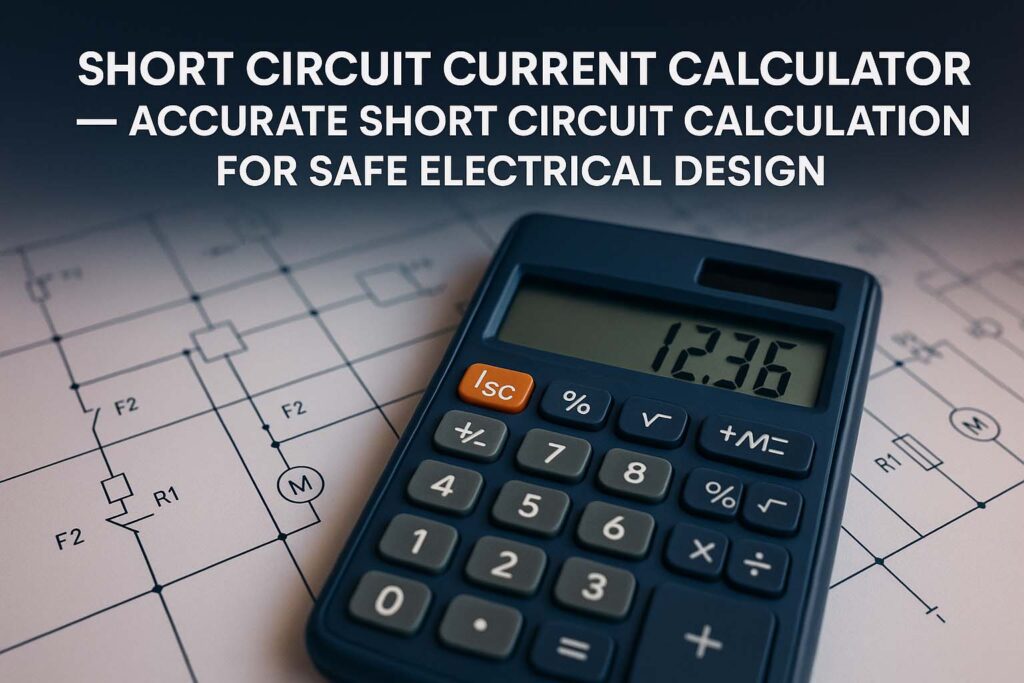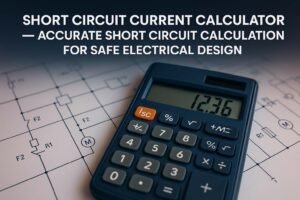Short Circuit Current Calculator: Best Tool
What is Short Circuit Current and Why Is It Important?
Short circuit current is the maximum current that can flow in an electrical system when a fault occurs. A fault could be a line-to-line fault, line-to-ground fault, or three-phase fault. These faults create a path with little or no impedance, causing excessive current to flow.
Table of Contents
Table of Contents

Why is this important? Because if not properly calculated, this current can damage equipment, melt cables, or even cause fires. Electrical protection systems such as breakers and relays are selected based on the fault current.
That’s where a short circuit current calculator comes in. It helps engineers, electricians, and technicians accurately estimate the fault current at various points in a system. This allows for safer designs, properly rated protection, and reduced risk.
Key Takeaways
- Understand what short circuit current is and why it’s crucial for electrical systems.
- Learn how a short circuit current calculator works and how to use it.
- Get detailed formulas and real-world examples for short circuit calculation.
- Explore types of fault current and why fault current calculators are essential in power systems.
- Use tables and technical insights to better design protection systems for industrial and residential setups.
Short Circuit Current Calculator
Short Circuit Calculation – The Basics
To perform a short circuit calculation, you need to understand the concept of impedance. Every electrical component — transformers, cables, generators — has impedance. This impedance limits the current during normal operation and during faults.
The basic formula for calculating short circuit current is:
Isc (kA) = (Fault MVA × 1000) / (√3 × V)
Where:
- Isc = Short circuit current in kA
- Fault MVA = Short circuit power at the point of fault
- V = System voltage (line-to-line) in volts
Use our online free tool Wire Size Calculator for Subpanels and Feeders – NEC Guidelines Included
For practical use, impedance is more often expressed in percentage (Z%) and used in this simplified form:
Isc = Full Load Current / (Z% / 100)
This formula gives the fault current at transformer or generator terminals.
Using a Fault Current Calculator for Electrical Systems
A fault current calculator automates the above calculations. You just enter the voltage, impedance, and system parameters — and it outputs the fault current. These calculators are especially useful when the system is complex with many components.
A fault current calculator typically requires:
- System voltage (V)
- Transformer kVA rating
- Impedance percentage of the transformer (%Z)
- Distance from source (optional, for cable impedance)
Example: Fault Current at Transformer Terminals
Let’s say we have a transformer:
- 1000 kVA
- 400 V
- Impedance = 5%
First, calculate full-load current:
Ifl = (1000 × 1000) / (√3 × 400) = 1443 A
Now calculate short circuit current:
Isc = Ifl / (Z% / 100) = 1443 / (5 / 100) = 28,860 A = 28.86 kA
This means the maximum fault current at the transformer’s secondary terminal is 28.86 kA.
Use our online free tool Amps to Wire Size Calculator – Choose the Right Cable for 10A, 20A, 40A Loads
Types of Short Circuits and Their Current Levels
Different types of faults generate different current levels. The three major types of faults are:
| Fault Type | Description | Current Magnitude |
|---|---|---|
| Three-Phase Fault | All three phases shorted together | Highest |
| Line-to-Line Fault | Two phases shorted | Medium |
| Line-to-Ground Fault | One phase shorted to ground | Lower |
A fault current calculator often includes options to select fault type because the fault impedance varies accordingly.
Factors Affecting Short Circuit Calculation
Several technical factors impact the result of a short circuit current calculation:
- Impedance of Source Equipment
The lower the impedance, the higher the short circuit current. - Cable Length and Size
Longer cables introduce higher resistance, reducing fault current at load ends. - System Voltage
Higher voltages typically yield higher short circuit levels. - Transformer or Generator Parameters
kVA rating and impedance % define the maximum fault MVA. - Motor Contribution
Motors near the fault location contribute to the fault current. Large industrial systems must consider this.
These factors make it essential to use a short circuit current calculator instead of manual guesswork.
Use our online free tool Wire Size Calculator for Solar Panels – Avoid Power Loss in Off-Grid and Hybrid Systems
Where to Use a Short Circuit Calculator
Such calculators are critical in the following scenarios:
- Designing electrical protection systems
- Performing arc flash analysis
- Sizing circuit breakers and fuses
- Conducting compliance checks for NEC, IEC, or IEEE standards
- Designing industrial substations and panel boards
- Verifying transformer or generator loading
If your design doesn’t accurately calculate fault current, your breaker may fail to trip in time — leading to severe consequences.
Short Circuit Current Calculation at Different Points
Below is a summary of typical calculation methods at different points:
| Point in System | Method | Considerations |
|---|---|---|
| At Transformer Secondary | Use %Z | Add cable impedance if fault is not at terminal |
| At Motor Control Center | Add cable + motor back-feed | Lower current than at transformer |
| At End of Feeder | Cable impedance dominates | Fault current drops significantly |
You can use online calculators that let you simulate these scenarios by inputting distances and cable sizes.
Tips for Using Fault Current Calculators Effectively
- Always enter accurate system voltage. Use line-to-line values for 3-phase systems.
- Make sure you know the exact transformer impedance from nameplate or design data.
- Include cable impedance when calculating faults far from the source.
- For large motors near fault locations, account for motor contribution.
- Cross-check with electrical codes (NEC, IEC) for allowable fault levels and breaker ratings.
- Use safety factors when designing for future expansions.
Use our online free tool Free Electrical Wire Size Chart & Calculator – Find the Right Cable Every Time
Common Mistakes in Short Circuit Calculations
Many designers skip small but critical factors, leading to wrong results. Common mistakes include:
- Ignoring cable impedance
- Not including motor back-feed in industrial setups
- Using wrong voltage level (line-to-neutral instead of line-to-line)
- Using nameplate full load current instead of calculated value
- Applying incorrect fault type assumptions
These mistakes can lead to selecting an underrated breaker or incorrect relay settings, which can endanger lives and equipment.
Advantages of Using an Online Short Circuit Current Calculator
| Feature | Benefit |
|---|---|
| Quick calculations | Saves time for designers and engineers |
| Accurate fault current values | Helps size protection devices correctly |
| Easy scenario testing | Modify distance, cable, or Z% instantly |
| Ensures code compliance | Prevents violation of safety standards |
| Prevents under/over design | Optimizes cost vs safety |
You can integrate these calculators into your design workflow or even embed them on websites for public use.
Conclusion: Why Short Circuit Calculators Are a Must-Have
Short circuit calculations are not optional — they’re critical. Any miscalculation can lead to catastrophic failure in an electrical system. That’s why using a short circuit current calculator is essential for engineers, contractors, and electricians.
Whether you’re designing a residential panel, an industrial motor control center, or a power distribution network, fault current calculators make your job easier, safer, and more accurate. They save time and improve protection system reliability.
For best results, always validate your calculations, consider all fault types, and account for every piece of equipment in the current path.
Use our online free tool Online Wire Gauge Calculator for 1 Phase and 3 Phase Load – Amp and Distance Based
FAQ – Short Circuit Current Calculator
Q1: What is the purpose of a short circuit calculator?
A: It calculates the maximum fault current to help in protection system design and breaker sizing.
Q2: Can I use this calculator for single-phase systems?
A: Yes, but ensure the formula is adjusted for single-phase voltage (V = 230V in many cases).
Q3: How accurate are online calculators?
A: They are generally accurate, provided you input correct data. Always verify results with manual calculations or software tools.
Q4: What’s the difference between fault current and load current?
A: Load current is the normal operating current. Fault current is the high current during a fault, many times larger than the load current.
Q5: Are there standards for short circuit calculations?
A: Yes. Common standards include IEEE 141, NEC, and IEC 60909.
Follow Us on Social:
Subscribe our Newsletter on Electrical Insights to get the latest updates in Electrical Engineering.
#ShortCircuitCalculator, #ElectricalSafety, #FaultCurrentCalculator, #ElectricalDesign, #PowerSystemAnalysis, #ElectricalEngineering, #ShortCircuitAnalysis, #CircuitProtection, #SafeElectricalDesign, #ElectricalCalculator, #EngineeringTools, #ElectricalLoadAnalysis, #ShortCircuitProtection, #IndustrialSafety, #ElectricalFaults
Short Circuit Current Calculator: Best Tool : Electrical Engineering Hub

Calculate fault current easily with our Short Circuit Current Calculator. Perfect for electrical engineers and designers to estimate short circuit levels, design safe protection systems, and ensure electrical safety compliance
Price Currency: USD
Operating System: All
Application Category: UtilitiesApplication
